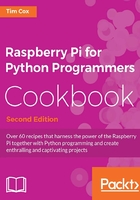
About the Author
Tim Cox lives in England with his wife and two young daughters and works as a software engineer. His passion for programming can be traced back to one Christmas in the mid 1980s when he received a Sinclair Spectrum 48k+ home computer (a joint present with his two elder brothers). By typing out and modifying BASIC programs, while dreaming about building robots, an interest in computers and electronics was sparked, which has never faded. This interest saw him through university, where he earned a BEng in Electronics and Electrical Engineering, and into a career in developing embedded software for a wide range of applications, for automotive, aerospace, and the oil industry, among others.
Keen to support the vision behind the Raspberry Pi, reignite engineering in schools, and encourage a new generation of engineers, Tim co-founded the MagPi magazine. Thanks to the dedication and time of the volunteers who contributed to it every month, it has become the official magazine for the Raspberry Pi and continues attract an ever-increasing number of readers (and writers) worldwide. Through his site PiHardware.com, Tim produces electronic kits and helps people learn about the Raspberry Pi and hardware interfacing; each of them is supported with detailed instructions and tutorials to help novices build the knowledge and skills for their projects.
This is Tim's first ever book; it mirrors his own experience of discovering the Raspberry Pi and showcasing its fantastic abilities.
Writing a book about the Raspberry Pi wouldn't have been possible without the creation itself, so thanks to the Raspberry Pi foundation for their hard work (and good humor) in making it a huge success. The Raspberry Pi community consists of an excellent group of exceptionally helpful people from all over the world, and it has been a pleasure to be involved with it from the start. In particular, I would like to thank The MagPi team that has supported me by reviewing the chapters and helping me achieve the best possible standard. Also thanks to the Pi3D team who worked hard to get their library running with Python 3 for the book.
Thanks to my family, particularly my wife Kirsty, who has supported me every step of the way and daily suffered my obsession with the Raspberry Pi. The excitement my daughters, Phoebe and Amelia, have as they discover new things inspires me to share and teach as much as I can.